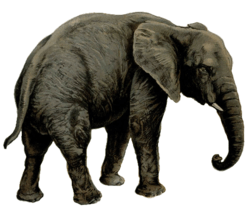Afroinsectiphilia
The Afroinsectiphilia (African insectivores) is a clade that has been proposed based on the results of recent molecular phylogenetic studies.[1] Many of the taxa within it were once regarded as part of the order Insectivora, but Insectivora is now considered to be polyphyletic and obsolete. This proposed classification is based on molecular studies only, and there is no morphological evidence for it.[2]
| Afroinsectiphilia | |
|---|---|
 | |
| Tailless tenrec | |
| Scientific classification | |
| Kingdom: | Animalia |
| Phylum: | Chordata |
| Class: | Mammalia |
| Superorder: | Afrotheria |
| Clade: | Afroinsectiphilia |
| Orders | |
The golden moles, otter shrews and tenrecs are part of this clade. Some also regard the elephant shrews and aardvarks as part of it, although these two orders were traditionally seen as primitive ungulates. The sister group of the Afroinsectiphilia is the Paenungulata, which were also traditionally regarded as ungulates.
If the clade of Afrotheria is genuine, then the Afroinsectiphilia are the closest relatives of the Pseudoungulata (here regarded as part of Afroinsectiphilia) and the Paenungulata. In a classification governed by morphological data, both the Pseudoungulata and Paenungulata are seen as true ungulates, thus not related to Afroinsectiphilia. However, DNA research is thought to provide a more fundamental classification.
Additionally, there might be some dental synapomorphies uniting afroinsectiphilians: p4 talonid and trigonid of similar breadth, a prominent p4 hypoconid, presence of a P4 metacone and absence of parastyles on M1–2. Additional features uniting ptolemaiidans and tubulidentates specifically include hypsodont molars that wear down to a flat surface; a long and shallow mandible with an elongated symphyseal region; and trigonids and talonids that are separated by lateral constrictions.[3][4]
Taxonomy
- INFRACLASS EUTHERIA: placental mammals
- Superorder Afrotheria
- Clade Afroinsectiphilia
- Order Afrosoricida
- Suborder Tenrecomorpha
- Family Potamogalidae: otter shrews; 3 species in 2 genera
- Family Tenrecidae: tenrecs; 31 extant species in 8 genera
- †Incertae familiae: Genus Plesiorycteropus; extinct aardvark-like tenrec relatives from the Late Pleistocene/Holocene of Madagascar[5]
- Suborder Chrysochloridea
- Family Chrysochloridae: golden moles; about 21 species in 9 genera
- Suborder Tenrecomorpha
- Order Macroscelidea: elephant shrews (according to some recent data part of Afroinsectiphilia)
- Order Tubulidentata: aardvark (according to some recent data part of Afroinsectiphilia)
- †Order Ptolemaiida: extinct carnivorous mammals, probably closely related to aardvarks.
- Order Afrosoricida
- Clade Paenungulata
- Clade Afroinsectiphilia
- Superorder Afrotheria
Phylogeny
| |||||||||||||||||||||||||||||||||||||||||||||||||||
| A cladogram of Afrotheria based on molecular evidence[6] |
References
- Asher, R. J.; Bennett, N.; Lehmann, T. (2009-07-06). "The new framework for understanding placental mammal evolution". BioEssays. 31 (8): 853–864. doi:10.1002/bies.200900053. PMID 19582725.CS1 maint: ref=harv (link)
- Rose, Kenneth David; Archibald, J. David (2005). The Rise of Placental Mammals: Origins and Relationships of the Major Extant Clades. JHU Press. p. 65. ISBN 0-8018-8022-X.
- Cote S, Werdelin L, Seiffert ER, Barry JC (March 2007). "Additional material of the enigmatic Early Miocene mammal Kelba and its relationship to the order Ptolemaiida". Proc Natl Acad Sci USA. 104 (13): 5510–5. Bibcode:2007PNAS..104.5510C. doi:10.1073/pnas.0700441104. PMC 1838468. PMID 17372202.
- Seiffert, Erik R (2007). "A new estimate of afrotherian phylogeny based on simultaneous analysis of genomic, morphological, and fossil evidence". BMC Evolutionary Biology. 7 (1): 224. doi:10.1186/1471-2148-7-224. PMC 2248600. PMID 17999766.
- Buckley, Michael (2013). "A Molecular Phylogeny of Plesiorycteropus Reassigns the Extinct Mammalian Order 'Bibymalagasia'". PLOS ONE. 8 (3): e59614. Bibcode:2013PLoSO...859614B. doi:10.1371/journal.pone.0059614. PMC 3608660. PMID 23555726.
- Tabuce, R.; Asher, R. J.; Lehmann, T. (2008). "Afrotherian mammals: a review of current data" (PDF). Mammalia. 72: 2–14. doi:10.1515/MAMM.2008.004.
